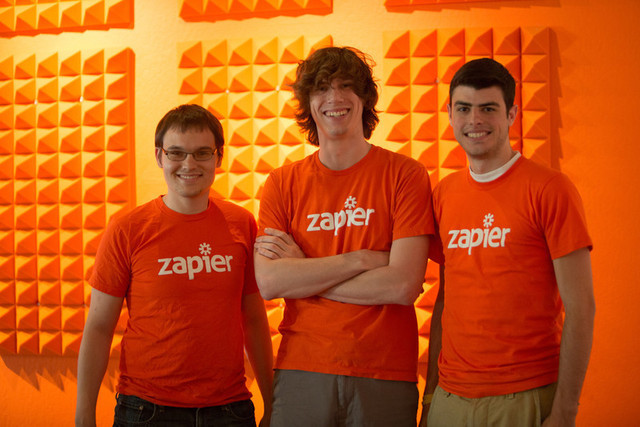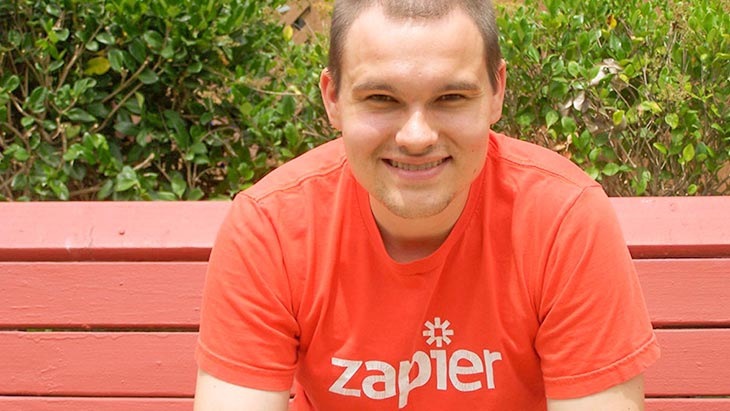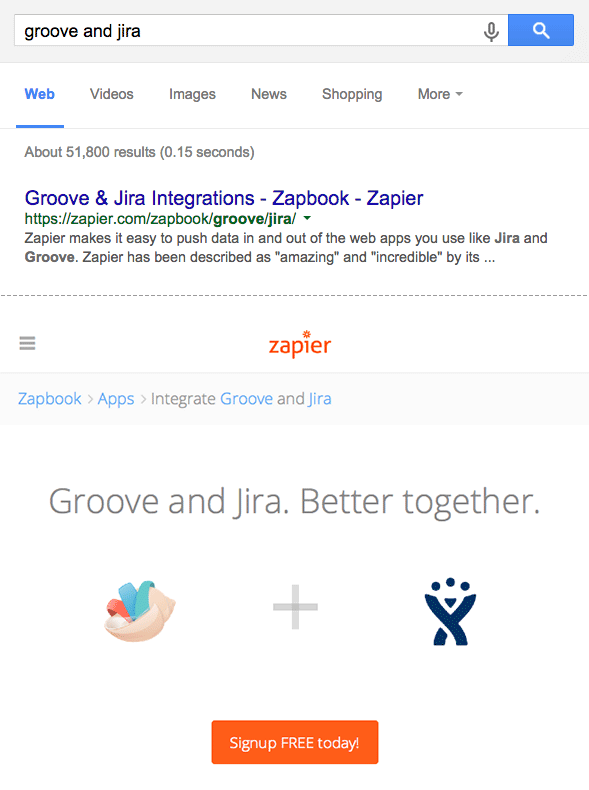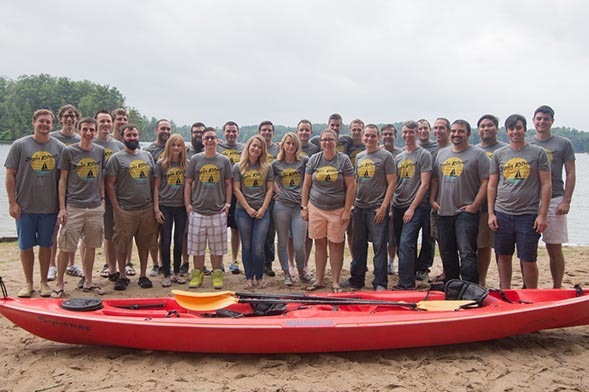600 thousand users in 3 years: History of Zapier
- Transfer

Wade Foster talks about the unusual beta of the Zapier application, attracting new users and successful remote work with employees.
The ability to integrate various software products among themselves is not a discovery, but the ability to effectively combine the two products is available exclusively for those who have programming at one level or another.
A few years ago, Zapier changed this situation.
The company has made the integration of [services] available to almost everyone. For example, for a marketer who wants to combine his email marketing software with an analytic application. Or for a director who needs to keep track of his tasks in the [application] Trello immediately from three other applications. All this can be done in the Zapier application, without any programming.
This application was liked by many, and more precisely, more than 600 thousand people. However, like any other successful business, Zapier started from scratch. The creators of Zapier were not technically savvy, and according to them, their resumes were not at all impressive, and their first application for getting into Y Combinator was immediately rejected.

It all started with Startup Weekend
Despite being a pet [at the moment] status in the startup community, Zapier does not go back to Silicon Valley. Not at all. Wade and two of its co-founders, Bryan Helmig and Mike Knoop, created the very first prototype of the app in just two days at the Startup Weekend event in Columbia, Missouri.
Inspired by the feedback they received, they decided to push their idea further. They applied for Y Combinator, but they were not accepted (see below for more on this). They were not like typical TechCrunch teams: for the sake of the project, they didn’t quit their job, they didn’t risk, they didn’t set themselves the task of gaining fame.
We wanted to succeed and create a full-fledged business, but we were in Colombia. There are few sources of funding. The projects working here finance themselves from current profits, so this project could not [immediately] replace the main work. We had to save our main work and organize an approach with this in mind - this is where we started.
A week after the Startup Weekend, on the night of Monday to Tuesday, we began to think about how to implement this, and set to work. The next few months, we worked nights and nights to create the first prototype and find the first users [to test the beta version of the application].
Unlike his co-founders, who were talented developers, Wade specialized in marketing, so his main goal was to attract users. It was not easy, because they only had a barely working prototype of the application on their hands.
First users
Zapier was not at all ready to go out, but this did not stop Wade from “knocking on people at the door” (or rather, on mailboxes).
We had a working prototype of the application - not too good, and certainly not so cool that the client immediately got carried away with it and formed its integration of services. And although clients still could not use the application themselves, I could install and configure it for them - which I did.
I called people on Skype, asked what services they wanted to connect, and did it for them. As a result, the client received a working bunch, just what was needed.
Wade was looking for possible ways to grow his business, and in the application support forums he found users who wanted to combine some services.
I searched the forums where users wrote about the integration of services and asked to make them for themselves. Evernote, Salesforce, Dropbox - all of these services have forums.
People wrote something like: “I like Evernote, it would be great if he worked in conjunction with Dropbox” or “I like MailChimp, it would be great if you made a decision connecting him and Wufoo.”
And I just left my comments on these forums: “Hello, see how you can do it: here is the API documentation for these two services, and if you know how to program, this is how it will work. OR there is another option: I'm currently working on a project with which you can integrate these services, so if you are interested, follow the link and let me know. "
These links left on the forums did not bring serious traffic - no more than 10-20 visitors from each link - about half of which converted and reported: "Yes, I want it."
In the early days of business deployment, this was incredibly important, and we were able to move from scratch with the help of such targeted advertising. And not only the forum participants drew attention to us. Wade became interested in the companies to which these forums belong.
Very soon, we got to know many of the employees of these companies because they contacted us and said: “Hello, your application looks cool, maybe we will cooperate?” - and this was the beginning of a partnership for Zapier.
These skype calls in the early stages of our business also became part of the future Zapier customer service culture.
The first prototype versions were constantly “falling”. It is very important to attract people who understand what the beta version is and forgive all errors in work and other inconveniences.
When something did not work, of course, I felt terrible, but it was a useful experience, so I called up with customers, explaining that the problem [which they pointed out] was already being solved.
If we found a mistake, we corrected it as soon as possible, and immediately informed the client: “Hello, do you remember the problem that we discussed on Skype? We solved it. ”
This level of first-customer service surprised many.
Kevin Hale, founder of Wufoo, told me that there are only three types of business.
You can create a business selling high-quality products. Companies like Apple are creating the very best of its kind and asking for the right price.
You can create a business that will offer the cheapest goods and services, for example, Walmart or Amazon.
The problem is that it is too difficult for a young company to compete in the market for the most expensive or cheapest services. Perhaps your product will not be the best (and expensive) as your product is brand new. And offering the cheapest is also difficult, because then you cannot take advantage of economies of scale.
And the third type of business you can build is to provide the very best customer service.
These words sunk into my soul, so from the very first day we decided: "Let's call on Skype, let's move forward in small steps, just to be able to make people happier, and they themselves will want to work with us."
Any startup can do this - offer great customer service. You don’t need to be a genius in order to be friendly and to help others.
An unusual way to attract users was not the only non-standard thing in the beta version of the Zapier application. They did not attract people to pay for using the first versions of the product. People paid for the privilege of using it.
To test their beta application, most companies simply offer: “Register, get the application for free, all you need to do is leave a review with suggestions for improvement. We will answer every offer. ”
They just beg customers. And we asked people to make a one-time payment to get our beta version. From the first few people for unlimited access to this version, we took $ 100. Then this figure varied - we asked for about $ 1, and in the end the price was set from about $ 5 to $ 10 for unlimited access to this version of the application.
This is not to say that we wanted to capitalize on beta. We wanted people to think that the application was worth the money and time spent on it (which they spent talking with us), even if they tested it for fun and were not going to use it on an ongoing basis. So this small obstacle helped us make some money and get the first few interested users who examined the application up and down and wrote a review about really important things.
How Zapier was not accepted (but later accepted) in Y Combinator
After developing the idea at Startup Weekend, the co-founders of Zapier decided to apply for the Y Combinator accelerator. The application was rejected.
None of us had an impressive resume. We are not engineering students at Stanford University working on awesome startups in the Valley. We have never been funded before. In our resumes, such things as “education of an industrial engineer” and “work in a mortgage company” were indicated.
We didn’t fit them at all. We thought: “Well, very bad. In any case, let's continue to do what we were going to. ” We were still working on our prototype, writing letters to people and developing our Zapier promotion strategies.
A year later, the team again applied, and this time the result was different.
The second time we already had a correctly working version of the application, for which a thousand people paid, and another ten thousand were waiting for the application to be released. We have integrated 25 different services into the [developed by ourselves] platform, we can say that we have gone from a newcomer to an unknown idea to developers, all the same without an impressive resume, but with a certain achieved result. This is the biggest change that has happened to us, and perhaps thanks to him we applied to YC again.
So what did the team achieve at YC? Surprisingly, their greatest achievement was not funding, communication, or education — what they usually expect from an accelerator graduate.
At YC, our seldom talked about achievement has been to understand the importance of customer focus. For three months we lived and worked in a tiny apartment and practically did not communicate with anyone. We just did that we wrote the code, created the application, worked with our users. It is impossible to lead such a lifestyle for a long time - you cannot work in this mode for years, but three months is quite possible, many people can definitely do it. And our progress during this time was simply tremendous.
They even began to recognize us in the technological field, as we tried to integrate all the most popular SaaS platforms (this helped us a lot). When we were young, nobody knew us, but thanks to the YC label, we seemed to people to be a promising company, and they were ready to support us and work with us.

SEO to attract new users
Creating a platform consisting of products from other companies, in itself, helped the Zapier team use the “power” of search results to increase their traffic.
We created landing pages for each application interaction option that could be combined. So if you are looking for Groove and JIRA, Zapier will also be in the search query.
Marketing with partners
There were more and more partners, and this became one of the largest sources of traffic for Zapier, and for customers of its partners Zapier also became of great value. Partners often helped by recommending integration with Zapier, but the Zapier team was capable of more.
With a hundred integrations with affiliate applications, the Zapier team knew how to help their partners conduct a more successful marketing campaign together.
At first we just asked [partners]: “Hi, recommend our application!” We asked [all] our partners to tweet, share information about us on Facebook, advertise us in any way. But then we realized that it was simply ineffective: neither we nor the partners received excellent results, and therefore we began to try different strategies with different partners.
We drew attention to the most successful advertising strategies and started working in this direction - when we created the new integration, we ourselves conducted a marketing campaign to promote it. People turned to us, because by this moment we had experience in creating integrations, and now they thought that we are the ones they need.
Thanks to this, we could come to a partner and say to him: “This is what we need to do together, and then Zapier and your service will succeed.” And in 99% of cases people answered us: “Great! Let's do it. ”
Create your own content
At first, search engine optimization and collaboration in marketing was enough to turn a startup into a real business. But about two years ago, the company began to invest much more in its content marketing. And it paid off instantly - almost 250,000 people now read Zapier's blog every month.
We felt that we needed to raise the bar. Our partnerships and search engine optimization strategies worked well, but Zapier seemed to us to be somehow unrecognizable. If you did not need our application, then there was no reason to know about its existence.
It seemed to me that we did not fully understand the mission of our own company, did not understand that what we had already done was worth the effort, and that it wasn’t, so we decided to use the potential of content marketing to tell people about ourselves: in this case, as soon as the blog reader needs application integration, he will first think about us.
We watched what celebrities did on the Internet and thought about how to become like them, while maintaining our own style and highlighting issues that, in our opinion, could attract potential users. So our blog was formed, where we started writing about applications, tools, productivity and the like. It took a lot of effort and time, and it was difficult.
In the first six months it was hard. Over the next six months - a little better. And in the last six months it has been great. This is very similar to personal savings. You must continue to invest little by little. If you make only one contribution, you will not get big profits, but if you constantly make investments for a long time, you will receive a large percentage from them, and ultimately, much more benefits.
How Zapier switched to telecommuting
The Zapier team has been staffed by people from all over the place.
The time spent at Y Combinator is the only time we worked together in the same place at the same time. After [releasing Zapier from] YC, when Mike's girlfriend (now wife) was in Missouri, Mike said, “I'm going to move there.”
Then we thought that he was very important for our company, and we were not going to lose him because of the move, so we just agreed to work remotely, after which he returned to Missouri. Mika, our first technical support employee, lived in Chicago, so we decided that we could work remotely. Other companies manage to work remotely, so we also decided to try.
Over time, distant work really became an important part of our [corporate] culture and identity, and we did great. Of course, it was difficult, but I think we have benefited from this a lot.
In order to create a [corporate] culture in which people want to work, we made regular employee meetings a priority for Zapier. Many companies consider remote work to be a “cheap option”, although they don’t actually consider this option, but if you work in the same office, you really have to pay for the rental of the premises.
However, instead of including office rent in the expense item, it’s better to include travel expenses there, because when working always remotely, you will definitely want to meet in person: it seems to me that at such personal meetings a certain connection is formed that cannot be established with remote work .

To summarize the above, there are things that can be done remotely to create a good corporate culture in some way. We have always hired people who care the same as us. We wanted to hire people who would really try to do their job really well, and who would think less about ping-pong tables and massagers, and would like to create high-quality products more.
It was easier for us to unite as a team, having employees in the company who care about the same as us. I also think that you need to hire slowly and for a specific purpose. If you hire a lot of employees too quickly (double the staff once every six months), then working remotely will most likely be impossible.
And one more absolutely necessary thing in the work is communication, regardless of whether it is remote or not.
Another important part of creating a strong culture is to make the team understand that even for the director, a balance of work and personal life is important.
I do not work 12 hours a day.
I have a pretty standard work schedule, and when my wife goes home, I go home too, we have dinner together and go to rest. I go to bed early, and waking up the next morning, I repeat my work day.
I never work on Saturdays, and on Sundays, maybe I will only play a little with Zapier, but this is more like checking the application is working. The worst thing I can do for my company is to pretend to be a superhero and work 16 hours a day, and after 18 months in this mode, realize that I can’t do this anymore.
All Zapier employees at least once worked in technical support.
There is one thing every Zapier employee must do, from developers to marketers, to work in customer support.
It doesn’t happen that you get a job [with us] and never talk to clients. If you do not want to serve customers - look for another place of work.
Our principle of work is that everyone should work in support.
Our engineers carry out all the technical work, and change periodically: today we have about 10 engineers, so that one week out of ten they work, serving customers.
This helps in many ways, because engineers can see what problems arise with the application and what customers are disappointed with.
The support team and other employees involved in the creation of the product always speak “in one language” about what is most important for users, because everyone already knows this.
Other employees, for example, from the marketing department or other departments, spend four hours in support every week, and this helps them better understand the desires of users, so that they care more about customers.
This is what we have been doing since day one, and it is a long way to creating a customer service oriented company.
Therefore, interviews on hiring new employees are fraught with unusual tasks for candidates: each of them must be well versed not only in their profession, but also in user support.
During the interview, we look for people who are attractive to us; if the engineer is really a professional in his field, but a little annoying, we probably won’t hire him because such people are not suitable for support work.
We also pay attention to how their letters to us are composed: are they friendly or short and callous? We just want our employees to write friendly letters to clients, so along the way we pay attention to such things.
We also ask questions, for example: “Have you ever had a wonderful user support?” We also ask one strange question to find out how the candidate will tell the client bad news: “Let's say you and I are meeting now, and you want to part with me on the phone. How do you tell me about this? ”
Sometimes in support you have to report bad news, but you still have to do it with sympathy, and so that the client is satisfied [with the service].
We ask all of our candidates what kind of startup literature they would recommend reading. Before you offer Paul Graham's essay and Thrifty Startup, listen to Wade’s valuable warning tip:
I think that the most important thing is to take action, try to do something, see what came of it and analyze it. You don’t just have to read for the sake of reading a business book, use the read as a motivation to do what you are going to do.
 Announcement:
Announcement:On October 1-3, 2015, Moscow will host the first Russian conference on the Lean startup and Customer development: Lean Startup Russia 2015 methodologies .
You can participate in the first day of the conference for free and use the “startuphub” promo code, which gives a 10% discount on any ticket (you can watch online broadcasts).
